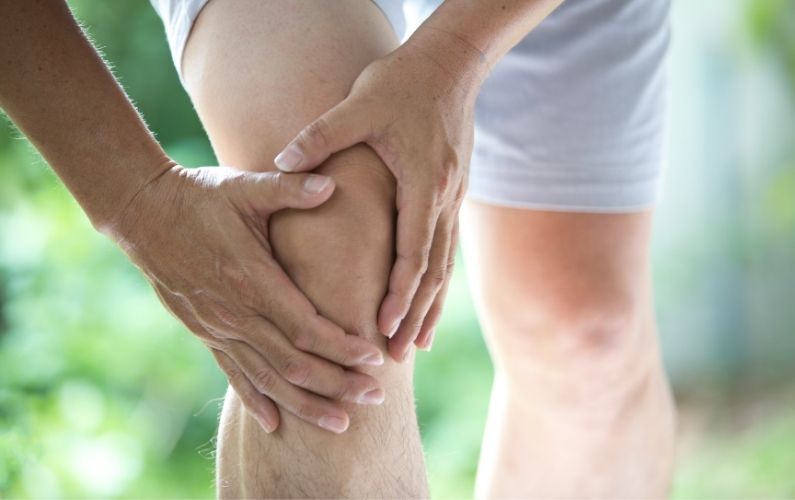Osteoarthritis Causes, Treatment & Prevention

Here’s everything you need to know about osteoarthritis causes, symptoms, treatment as well as lifestyle changes you can make to reduce your risk.
So, you have been informed by your doctor that the joint pain you are experiencing is osteoarthritis pain. What does that mean and what can you do about it?
Osteoarthritis is the most common form of arthritis. While other forms of arthritis are autoimmune diseases, osteoarthritis is not. Instead, it’s the result of the joints wearing away the healthy cartilage in a given area over prolonged periods of time. In other words, it can be caused by wear and tear on the joints over time.
If you have osteoarthritis, it may be time to consider physical therapy or potentially, a weight loss plan. The goal is to avoid any further damage to the cartilage within the joint, as it’s no longer capable of regenerating on its own. As a result, maintaining a healthy weight is crucial because it helps ease the pressure on your joints.
Keep reading to learn more about osteoarthritis pain, its causes, and treatment options.
Osteoarthritis Causes, Treatment & Prevention
Osteoarthritis is a degenerative joint disease that causes pain, swelling, and reduced function in the joints of hands, hips, feet, knees, and spine.
In Canada, approximately 3.9 million people above the age of 20 have been diagnosed with osteoarthritis.
Osteoarthritis has a wide range of negative effects on quality of life. This includes pain, physical limitations, and depression, which can all have an impact on a person’s ability to participate in social and occupational activities.
Osteoarthritis Causes
Osteoarthritis can be caused by wear and tear associated with ageing. It can also be due to the body failing to mend damaged joint tissues.
These joint tissues could have been damaged by past injuries, such as dislocated joints, torn cartilage, and ligament injuries. Obesity, poor posture, and joint malformation can also result in your joints becoming damaged.
Risk Factors
These factors can all contribute to your increased risk of developing osteoarthritis:
- Obesity. Extra weight puts stress on weight-bearing joints, such as your hips and knees.
- Gender. Women are more likely than men to develop osteoarthritis.
- Age. The chance of developing osteoarthritis increases with age.
- Certain metabolic diseases. These include diabetes and hemochromatosis (a condition in which your body has too much iron).
- Deformed bones. Some infants are born with malformed joints or faulty cartilage.
- Joint injuries. Osteoarthritis is more common in individuals who have had an injury or sustained trauma. Injuries, such as those caused by sports or accidents, can raise the chance of osteoarthritis.
- Genetics. If your family has a history of osteoarthritis, it’s possible you may be at risk too.
- Excessive stress on the joints. If you work a physically demanding or athletic position that puts strain on your joints, you may eventually suffer from osteoarthritis.
Osteoarthritis Symptoms
Common osteoarthritis symptoms include:
- Aching joints: Joints that hurt and feel stiff in the morning.
- Pain: Pain in and around your joint. Pain doesn’t always mean there is damage; it could be due to other causes such as bumping the joint or after a long period of time standing on your feet. However, pain with joint movement could be a sign of osteoarthritis.
- Swelling: The joint will swell up if it is overused, such as from repetitive use or extreme weight-bearing. Swelling is common in people with arthritis and some rheumatic conditions, but not always present.
- Limited mobility: Over time, wear and tear may cause some of the cartilage between bones to wear down or disappear. This makes it harder for two surfaces in a joint to glide over one another without pain. As a result, mobility may be limited.
- Weakness: The joints may become weaker. This can make them feel stiff when you get up in the morning and throughout the day during activities like walking.
Osteoarthritis Treatment
Osteoarthritis treatment is simply geared towards relieving painful symptoms and reducing further damage. There is no cure for osteoarthritis, but there are many treatments available that can help to improve quality of life. Treatment usually includes the use of anti-inflammatory medications, home remedies, lifestyle modifications, and physical therapy.
Medications
There are various over-the-counter and prescription medications that can help relieve symptoms of osteoarthritis. Speak with one of our pharmacists today to learn more about which options would be suitable for you.

Lifestyle Modifications
Hot and Cold Therapy
To alleviate muscular discomfort and stiffness, you may use hot or cold therapy. Apply a cold or hot compress to painful joints every day for 15 to 20 minutes at a time.
Exercise
Physical activity helps to strengthen the muscles surrounding your joints and may reduce stiffness. Try your best to complete 30 minutes of moderate, low-impact physical activity every day.
Choose gentle, low-impact exercises like walking or swimming for better joint mobility and pain relief. Tai chi and yoga also aid in joint flexibility improvement and pain management.
Adequate Sleep
Resting your muscles can aid in the reduction of swelling and inflammation. In addition, getting enough sleep at night is beneficial for pain management too.
Weight Loss
If you are overweight, you have a higher chance of straining your joints, which can cause a lot of discomfort. Shedding off some extra weight will help relieve this stress and reduce pain.
How to Prevent Osteoarthritis
Here are some tips that you can follow to reduce your chances of developing osteoarthritis.
Manage Occupational Risks
If your job requires a lot of repetitive motion such as lifting, walking, kneeling, and twisting, it might be harmful to your joints. Talk to your physician about ways to reduce your risk.
Exercise
Low-impact activities can benefit your joints. In addition to aerobics, look for exercises that include strength training and stretching. Exercise benefits you by:
- Maintaining the health of your joints
- Relieving stiff muscles
- Reducing fatigue and pain
- Improving bone and muscle health
- Maintaining a healthy weight
Overweight and obese individuals are at an elevated risk of developing osteoarthritis. Excess weight can cause joint cartilage to deteriorate faster. Likewise, weight reduction can help reduce pain in people who are overweight or obese.

Rest
Overuse of joints can raise the risk of osteoarthritis. However, physical activity may also help people maintain healthy bones and muscles. The key is to maintain balance.
Give your joints a rest if they are swollen or painful and avoid overexerting yourself. Limiting the movement of a badly damaged joint reduces the danger of developing osteoarthritis there in the future.
Control Your Blood Sugar
According to the Arthritis Foundation, diabetes is a potential risk factor for osteoarthritis. High levels of glucose can speed up the formation of molecules that make cartilage rigid. Consequently, diabetes can also cause inflammation, which promotes cartilage deterioration. Limiting your sugar intake and keeping diabetes in check can aid in the prevention of osteoarthritis.
Conclusion
The best way to prevent or manage osteoarthritis is with early intervention through lifestyle changes, diet modifications, exercise, weight loss, physical therapy, and pain management.
Finally, be sure to consult a pharmacist about over-the-counter medications or prescription drugs that will help alleviate your osteoarthritis pain.
References:
https://www.canada.ca/en/public-health/services/publications/diseases-conditions/osteoarthritis.html
https://www.mayoclinic.org/diseases-conditions/osteoarthritis/symptoms-causes/syc-20351925
https://www.webmd.com/osteoarthritis/oa-pain-relief-risks-benefits


